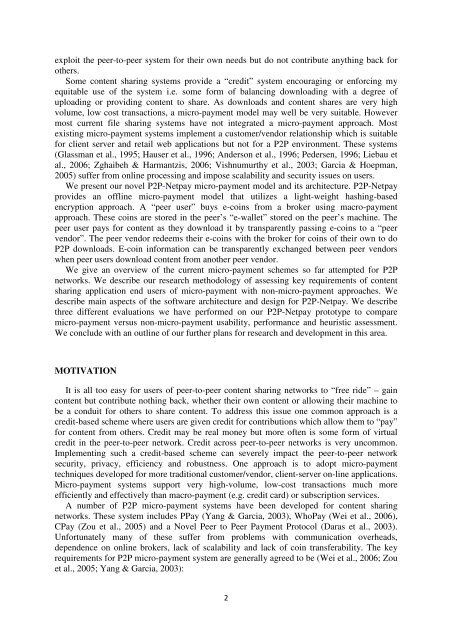View - Faculty of Information and Communication Technologies
View - Faculty of Information and Communication Technologies
View - Faculty of Information and Communication Technologies
Create successful ePaper yourself
Turn your PDF publications into a flip-book with our unique Google optimized e-Paper software.
exploit the peer-to-peer system for their own needs but do not contribute anything back for<br />
others.<br />
Some content sharing systems provide a “credit” system encouraging or enforcing my<br />
equitable use <strong>of</strong> the system i.e. some form <strong>of</strong> balancing downloading with a degree <strong>of</strong><br />
uploading or providing content to share. As downloads <strong>and</strong> content shares are very high<br />
volume, low cost transactions, a micro-payment model may well be very suitable. However<br />
most current file sharing systems have not integrated a micro-payment approach. Most<br />
existing micro-payment systems implement a customer/vendor relationship which is suitable<br />
for client server <strong>and</strong> retail web applications but not for a P2P environment. These systems<br />
(Glassman et al., 1995; Hauser et al., 1996; Anderson et al., 1996; Pedersen, 1996; Liebau et<br />
al., 2006; Zghaibeh & Harmantzis, 2006; Vishnumurthy et al., 2003; Garcia & Hoepman,<br />
2005) suffer from online processing <strong>and</strong> impose scalability <strong>and</strong> security issues on users.<br />
We present our novel P2P-Netpay micro-payment model <strong>and</strong> its architecture. P2P-Netpay<br />
provides an <strong>of</strong>fline micro-payment model that utilizes a light-weight hashing-based<br />
encryption approach. A “peer user” buys e-coins from a broker using macro-payment<br />
approach. These coins are stored in the peer’s “e-wallet” stored on the peer’s machine. The<br />
peer user pays for content as they download it by transparently passing e-coins to a “peer<br />
vendor”. The peer vendor redeems their e-coins with the broker for coins <strong>of</strong> their own to do<br />
P2P downloads. E-coin information can be transparently exchanged between peer vendors<br />
when peer users download content from another peer vendor.<br />
We give an overview <strong>of</strong> the current micro-payment schemes so far attempted for P2P<br />
networks. We describe our research methodology <strong>of</strong> assessing key requirements <strong>of</strong> content<br />
sharing application end users <strong>of</strong> micro-payment with non-micro-payment approaches. We<br />
describe main aspects <strong>of</strong> the s<strong>of</strong>tware architecture <strong>and</strong> design for P2P-Netpay. We describe<br />
three different evaluations we have performed on our P2P-Netpay prototype to compare<br />
micro-payment versus non-micro-payment usability, performance <strong>and</strong> heuristic assessment.<br />
We conclude with an outline <strong>of</strong> our further plans for research <strong>and</strong> development in this area.<br />
MOTIVATION<br />
It is all too easy for users <strong>of</strong> peer-to-peer content sharing networks to “free ride” – gain<br />
content but contribute nothing back, whether their own content or allowing their machine to<br />
be a conduit for others to share content. To address this issue one common approach is a<br />
credit-based scheme where users are given credit for contributions which allow them to “pay”<br />
for content from others. Credit may be real money but more <strong>of</strong>ten is some form <strong>of</strong> virtual<br />
credit in the peer-to-peer network. Credit across peer-to-peer networks is very uncommon.<br />
Implementing such a credit-based scheme can severely impact the peer-to-peer network<br />
security, privacy, efficiency <strong>and</strong> robustness. One approach is to adopt micro-payment<br />
techniques developed for more traditional customer/vendor, client-server on-line applications.<br />
Micro-payment systems support very high-volume, low-cost transactions much more<br />
efficiently <strong>and</strong> effectively than macro-payment (e.g. credit card) or subscription services.<br />
A number <strong>of</strong> P2P micro-payment systems have been developed for content sharing<br />
networks. These system includes PPay (Yang & Garcia, 2003), WhoPay (Wei et al., 2006),<br />
CPay (Zou et al., 2005) <strong>and</strong> a Novel Peer to Peer Payment Protocol (Daras et al., 2003).<br />
Unfortunately many <strong>of</strong> these suffer from problems with communication overheads,<br />
dependence on online brokers, lack <strong>of</strong> scalability <strong>and</strong> lack <strong>of</strong> coin transferability. The key<br />
requirements for P2P micro-payment system are generally agreed to be (Wei et al., 2006; Zou<br />
et al., 2005; Yang & Garcia, 2003):<br />
2
















